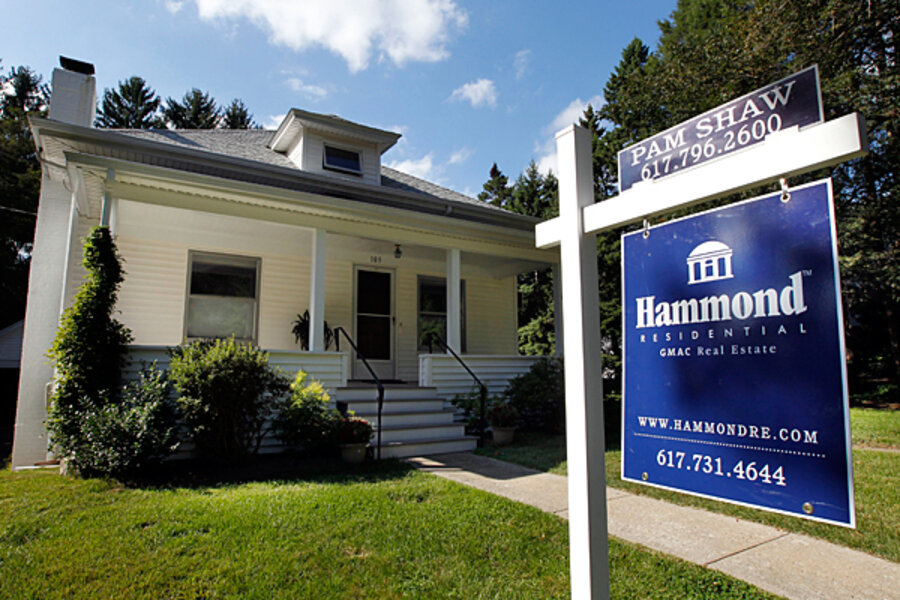Home sales jump in August: why it's not enough to revive housing market
Loading...
Americans bought nearly 8 percent more homes in August than in July, a welcome sign of progress for the still-troubled US housing market.
For the first time since April, sales of previously owned homes rose to an annualized rate of more than 5 million per year. The median sales price was $168,300, down from $177,300 a year before, the National Association of Realtors reported Wednesday.
Despite the gains in sales volume, unsold inventory fell only slightly, to 3.6 million units for sale. And housing market experts say the additional "shadow inventory" remains large, including homes held by delinquent borrowers who will eventually face foreclosure.
The problem is reflected in a new forecast that US home prices, on average, will not keep pace with inflation over the next four years. Home prices are likely to post nominal gains of about 1 percent a year through 2015, according to a MacroMarkets poll of a diverse group of 111 economists and real estate experts.
By comparison, the Federal Reserve expects inflation to run as much as 2 percent a year over that time.
Robert Shiller, the founder of MacroMarkets and a Yale University economist, said the outlook among forecasters has dimmed somewhat in recent months.
“Markets and government institutions are visibly struggling to respond consistently to an unprecedented rash of crises and conflicts," Mr. Shiller said in releasing the survey Wednesday. "These struggles diminish confidence" within the private sector, he said.
A slow recovery for the housing market would mean that millions of mortgagees remain in a "negative equity" position, with loan balances exceeding the value of their homes.
Still, even a modest rise in home prices would represent some stabilization in a market that has seen dramatic swings over the past decade or so.
For 6-1/2 years starting in 2000, home prices rose by about 10 percent a year, according to Shiller's data. In the most recent five years, prices have fallen by 7 percent a year.
The difficulties of the housing market – from relatively tight credit conditions for new borrowers to weak conditions for home builders – continue to restrain overall economic growth, forecasters say.
A big question is what can be done to aid a housing recovery and work through the backlog of properties in or near foreclosure.
In his recent set of job-creation proposals, President Obama said his administration is pursuing new steps to help at-risk borrowers refinance to avoid foreclosure. So far, efforts on that front have had only modest success.
Some housing experts say the best approach at this point is a hands-off one, whether the result is a slow recovery or a further decline in home prices.
Rep. Gary Ackerman (D) of New York recently announced a proposal to focus on a different kind of intervention: seeking to spur demand among home buyers.
Named after the 1862 Homestead Act, this plan would offer down-payment assistance to the first two million creditworthy borrowers, in the form of a matching subsidy up to $20,000.
In addition to that move, which is aimed at single-family owners, the bill would also encourage purchases of homes for rent, by offering a 10-year tax exemption on rental income for a million buyers.
Economist Ed Yardeni, who helped formulate this plan, argues that it would be a relatively efficient way to speed buyers, sellers, and builders on the path back toward a more normal housing market.
Of course this is just one of many ideas on how to address the housing issue. But Mr. Yardeni, who heads a research firm based in Great Neck, N.Y., says it has the virtue of simplicity and a comparatively low cost (he estimates $40 billion).
And compared with other job-creation plans, this idea targets directly what Yardeni says is the economy's "biggest problem."
Patrick Newport, a housing economist at IHS Global Insight, says the boost in home sales during August came mostly from investor buyers, although home purchases also rose among people planning to live in the homes.
Mr. Newport, in a written analysis, also said that the level of sales reported by the National Association of Realtors (NAR) will be revised downward in coming months. That's because the group is reviewing its data-tracking process, after other housing-industry companies suggested that the NAR sales numbers have been too high by as much as 15 or 20 percent.





